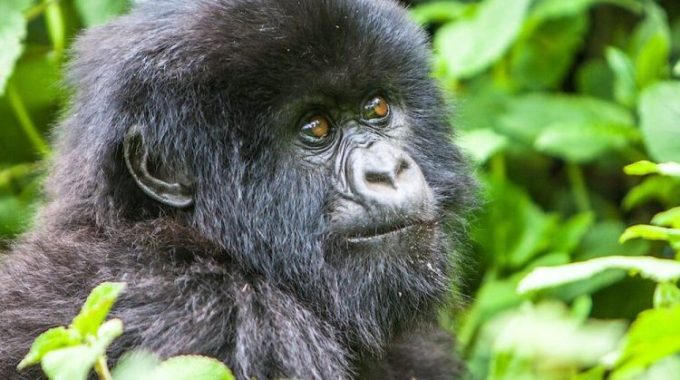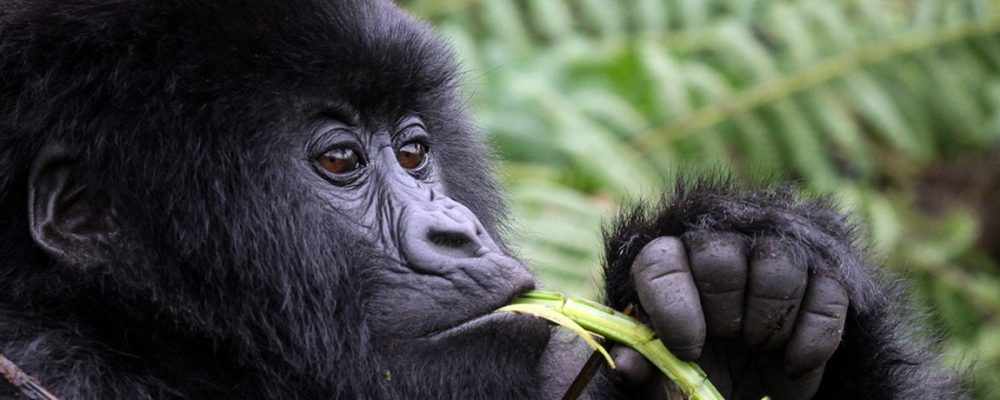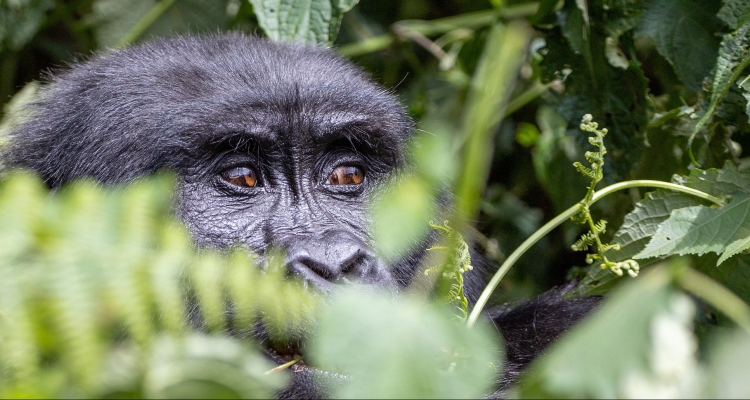
5 Reasons Why You Need to See Gorillas in Uganda
5 Reasons Why You Need to See Gorillas in Uganda
With about 1,064 mountain gorillas remaining in the wild, sitting in silence on the cold ground of Uganda’s rain forests for 60 minutes – about 7 meters from the huge silverback is one of life’s greatest privileges.
Gorilla trekking in Uganda provides a rare opportunity to observe the everyday interactions of the gentle, mysterious primates.
Mountain gorillas live only in the dense vegetation of Uganda’s Bwindi Impenetrable Forest National Park and along the dormant volcanic Virunga mountain range that stretches across Rwanda’s Volcanoes National Park, DR.Congo’s Virunga National Park and Uganda’s Mgahinga Gorilla National Park.
Mountain gorillas live only in high altitude montane and bamboo forests, between 8,000 – 13,000 feet (1,400m to 3,800 meters), surrounded by human settlements.
- You will Be Where Half of the World’s Mountain Gorillas Live
In Uganda there are two gorilla trekking options; Bwindi Impenetrable National Park and Mgahinga Gorilla National Park. Gorillas don’t pay mind to political borders so populations across over the Virunga are relatively fluid.
Uganda has an edge, however, since Bwindi Forest alone is home to half of the world’s mountain gorillas.

Bwindi Impenetrable National Park (also called “The Place of Darkness” due to its dense treetops) is an ancient, montane and lowland forest spanning 128 square miles. This region was named a UNESCO World Heritage Site thanks to its incredible biodiversity and the large number of endangered species that thrive in it.
Mgahinga Gorilla National Park has an area of 13 square miles of the larger Virunga habitat, which stretches across 168 square miles into Rwanda and the Democratic Republic of the Congo. The national park has three of the eight major Virunga peaks: Mount Gahinga, Mount Muhabura and Mount Sabyinyo.
- By Supporting Community Enrichment You Can Fight Habitat Destruction
The main threat to the livelihood of mountain gorillas is habitat destruction. Communities around the parks are heavily population, and residents have traditionally used land around the national park boundaries for farming or logging.
Since tourism is now the most lucrative industry in Uganda, and the majority of tourists come to see mountain gorillas, trekkers are encouraged to seek out ways to give back to the communities they visit.
One popular option is to hire a porter, who is always a local resident and occasionally a former poacher. The landscape within Bwindi Impenetrable National Park and Mgahinga Gorilla National Park is unpredictable and difficult to navigate; porters help guide trekkers through river crossings and up steep, muddy inclines. Other options is to participate in community-led cultural initiatives. In Bwindi Village, the Bwindi Bar trains disenfranchised young adults in hospitality through rigorous classes and work experience.
Around Mgahinga, elders of the Batwa tribe lead visitors on a forest tour along the Batwa Trail, explaining how their self-sufficient, forest – dwelling tribe traditionally used medicinal plants.
- You will Find More Affordable Trekking Permits : 5 Reasons Why You Need to See Gorillas in Uganda
To make sure the gorillas stay healthy and wild, there are strict regulations in place. Staring with the gorilla trekking permit process. Daily viewing of each gorilla group are extremely limited to only one hour, so visitors should apply well before their desired dates.
In Uganda, gorilla permits cost USD$ 800 per person per trek as of 2025. Gorilla permits in Rwanda cost USD$ 1,500 per person per trek.
Most gorilla trekking in Uganda takes place in Bwindi Impenetrable National Park, where there are multiple starting points and several gorilla families to trek. The park has four gorilla trekking sections – Buhoma, Rushaga, Nkuringo and Ruhiji gorilla trekking sectors. Visitors are led by park rangers and groups of eight are allowed to observe the gorillas for one hour, in silence and at a safe distance.
- You Can Take on Challenging Terrain : 5 Reasons Why You Need to See Gorillas in Uganda
A look at the Southwestern Uganda’s green terraced hills and rolling volcanic slopes and its clear this area of Uganda is not for the faint hearted. Adding on the high altitude and the challenging terrain, and gorilla trekking in Uganda promises to be the adventure of a lifetime.
To reach the gorillas is hard work. It requires navigating uphill and downhill through thick tangles of vines, thorns and roots. The appropriately named Bwindi Impenetrable National Park is only accessible by foot, as there are not paths, no signs, no directions and more often than not, no clearing (which is why the park rangers carry machetes).
The good news is the reward that seems to be much better after all of the hard work.
- You will Inevitably Cross Paths with Other Primates : 5 Reasons Why You Need to See Gorillas in Uganda
Uganda is a primate lover’s dream land. In addition to the endangered mountain gorillas, Mgahinga Gorilla National Park is home to another endangered species, the golden monkey. These furry, comical monkeys live high up in bamboo forests.

Tracking golden monkeys is very similar to tracking gorillas, but the trek itself is not quite as challenging. Furthermore, Bwindi Forest has L’hoest monkeys, gray-cheeked mangabeys, and blue monkeys. In Kibale Forest National Park, chimpanzees are the show stopper. Patas monkeys roam around Murchison Forest National Park and Queen Elizabeth National Park hosts blue monkeys, red –tailed monkeys and chimpanzees in the Kyambura Gorge.
In conclusion – Gorilla trekking is a highlight of all safaris to Uganda and is a major reason why millions of tourists visit Uganda. Bwindi Impenetrable National Park and Mgahinga Gorilla National Park offer the best gorilla trekking experience in the world.
To take part in gorilla trekking in Uganda, you need to purchase a gorilla permit costing US$800 per person per trek. Due to high demand for gorilla trekking and limited number of gorilla permits available on a daily, booking early for a gorilla permit is recommended.
